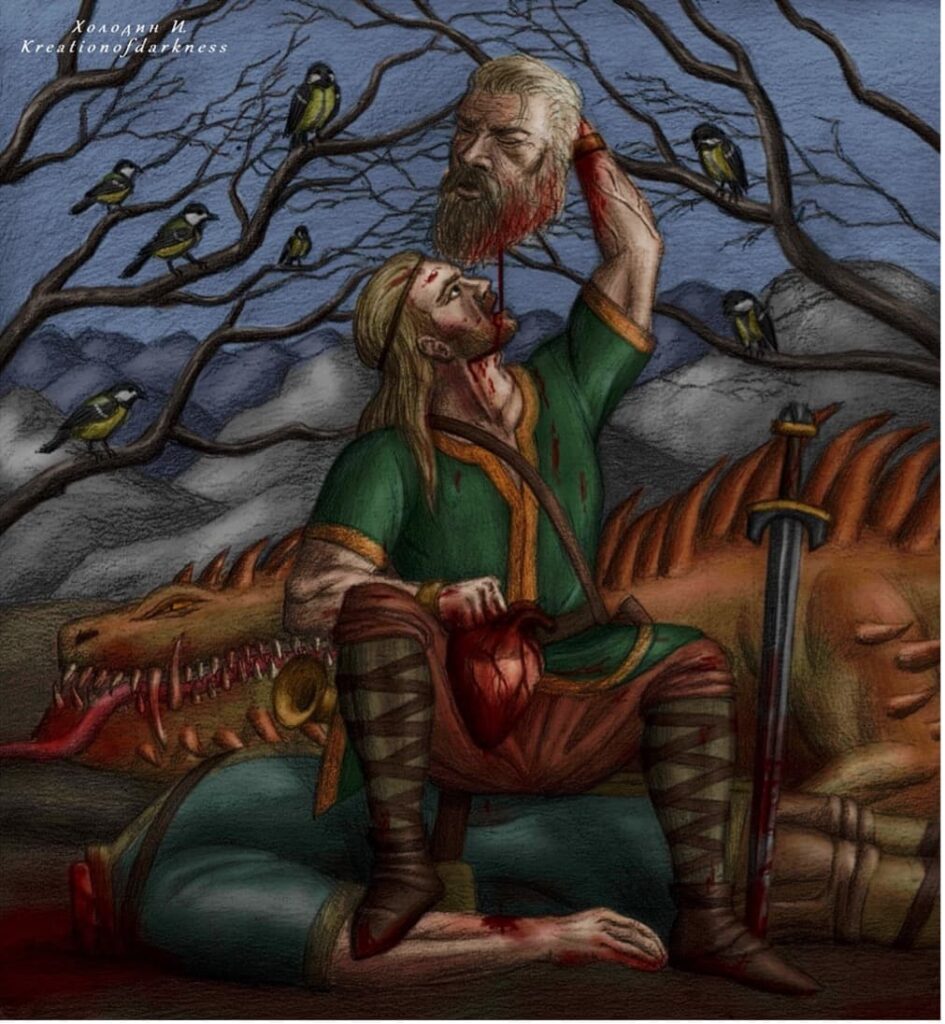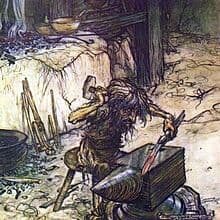Sympathetic or Sinister?: How Morris Alters Our Perspective on Sigurd
By Samantha Costa.
William Morris’ “The Story of Sigurd the Volsung” is so devoted to its source material, Saga of the Volsungs, that reading one after the other feels almost repetitive. However, Morris’ darkened and more intense tone completely shifts the audience’s perspective of some of the most critical scenes in the story.
Humanity in a Villain?
One of the scenes that is most affected by Morris’ dramatic retelling is the moment after Sigurd kills Fafnir, when Regin fully realizes what the hero has done. In the original, Regin is filled with a sense of regret that the audience can only perceive as pitiful. Despite Sigurd’s reassurance that Regin had no part in the killing, Regin only sorrowfully repeats:
You have killed my brother, and I can hardly be considered blameless in this deed.
(Saga 65)

It’s a striking moment of familial grief and regret, especially within a culture that accepts mothers killing their own children for the sake of honor. Perhaps, according to the values of Viking culture, Regin’s regret is a sign of weakness and cowardice since a true hero would never regret doing an honorable deed…
...even when it means hurting your family.
To a modern audience, however, Regin’s acceptance of blame and his humanizing display of emotion draws the reader’s sympathy and, though they know Regin had previously been plotting to betray Sigurd, makes us feel sorry when Sigurd mercilessly cuts off his head moments later.
But in Morris’ retelling, any sympathy the reader may have had in the original for Regin’s grief is quelled.
Let’s compare Regin’s demeanor in both versions:
How Morris Describes Regin
- scowl[ing]
- crouched
- darkened
(Morris 114)
How the Volsungsaga describes Regin
- emotion[al]
- sorrow[ful]
(Saga 65)
(Morris 114)
Thou has slain my brother.
Morris also removes the humanizing acceptance of guilt from Regin’s words. Instead of repeating himself only once in a sober recognition of grief, Regin repeats the phrase a disconcerting four times. He antagonizes Sigurd with every response he gives.

Let’s return to this image from the top of the page. It’s Sigurd’s slaughter of Regin, the very scene that the setups in “The Story of Sigurd the Volsung” and the Saga of the Volsungs influence their readers to think about differently. The image takes a creative liberty by depicting Sigurd savagely drinking the blood from Regin’s neck.
We as the readers must make a decision…
Is Sigurd “bloodthirsty” in this way, cruelly murdering a man who perhaps had the potential to be good?
Or is he, as Morris suggests, simply killing an evil man who clearly seeks to betray him?
What do you think? Vote here to decide!
In Defense of Morris (and Sigurd)
Though that picture makes a compelling case, it’s important to think about how the authors actually intended for us to think about Regin. With such an obvious shift in his character, Morris more clearly reminds the audience of Regin’s true, treacherous intentions, leaving no question about his evil nature. The audience, like Sigurd, is unsettled by Regin’s uncanny and irritated behavior, especially after he only did as Regin prompted. Unlike the Saga, the more in-depth Victorian characterization in “The Story of Sigurd the Volsung” darkens the scene so effectively that the audience holds no reservations about Sigurd’s killing of Regin shortly after.
Morris reminds us of who Regin really is by refusing to humanize him in the moments before his death.“The Story of Sigurd the Volsung” draws the readers away from sympathy by exposing the darker and more sinister side of Regin’s character that The Saga of the Volsungs fails to explore.






